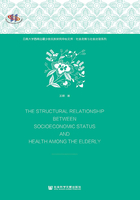
1.2.3 Mid-range Factor: Social lnteraction and Health
After reaching old age, individuals have much more leisure time as a result of retirement from activities they used to be responsible for, such as work, household duties and social activities. Social interactions with other people are a crucial part of daily life for elderly people.
Since the mid-1970s, there has been a rapid increase in epidemiological research on the effect of social interaction on health status and longevity. It is well-known that social interaction has a powerful impact on health in old age. Lack of social interaction predicts poor physical health, low subjective well-being
low subjective well-being and mortality from all causes.
and mortality from all causes. The reasons are that social interaction may be beneficial to promoting access to information about health and health-related behaviors, rendering emotional support to cope with stress, providing tangible help,
The reasons are that social interaction may be beneficial to promoting access to information about health and health-related behaviors, rendering emotional support to cope with stress, providing tangible help, and supplying more opportunities to go outside and do exercise.
and supplying more opportunities to go outside and do exercise.
Social interaction has a greater effect on the life of the elderly than on other age groups in the human population. Unger and his fellow authors indicated that the beneficial effects of social interaction were stronger for male respondents in a sample of initially high-functioning men and women aged 70 to 70 years over a 7-year period from the MacArthur Study of Successful Aging.
Unger and his fellow authors indicated that the beneficial effects of social interaction were stronger for male respondents in a sample of initially high-functioning men and women aged 70 to 70 years over a 7-year period from the MacArthur Study of Successful Aging. Avlund et al. used data from 1396 older non-disabled adults from the Danish Intervention Study on Preventive Home Visits to investigate whether social interaction was related to physical health(disability)and whether these associations vary by age and gender.
Avlund et al. used data from 1396 older non-disabled adults from the Danish Intervention Study on Preventive Home Visits to investigate whether social interaction was related to physical health(disability)and whether these associations vary by age and gender. A large diversity in social interaction and high social participation was important in maintaining functional ability among men and women aged 75 years. Being embedded in a strong network of social relationships provides protection against functional impairment. Mendes de Leon et al. also reported a similar but more specific result that being embedded in a social network of friends and relatives, not of children or a confidant, reduces the risk for functional decline, as well as enhancing recovery from activity of daily living(ADL)disa bility.
A large diversity in social interaction and high social participation was important in maintaining functional ability among men and women aged 75 years. Being embedded in a strong network of social relationships provides protection against functional impairment. Mendes de Leon et al. also reported a similar but more specific result that being embedded in a social network of friends and relatives, not of children or a confidant, reduces the risk for functional decline, as well as enhancing recovery from activity of daily living(ADL)disa bility. In addition, gender differences in the influence of social interaction on the subjective well-being of Japanese older adults were determined among 498 elderly over a three-year survey interval.
In addition, gender differences in the influence of social interaction on the subjective well-being of Japanese older adults were determined among 498 elderly over a three-year survey interval. Interactions with children had benefits on satisfaction only among elderly women. Social interaction quantity and quality were inversely associated with mortality,
Interactions with children had benefits on satisfaction only among elderly women. Social interaction quantity and quality were inversely associated with mortality, and exerted independent effects on mortality.
and exerted independent effects on mortality. A community sample consisting of 331 individuals 65 years and older in North Carolina, America was assessed by Blazer, who found that the frequency of social interaction significantly predicted thirty-month mortality.
A community sample consisting of 331 individuals 65 years and older in North Carolina, America was assessed by Blazer, who found that the frequency of social interaction significantly predicted thirty-month mortality.
A growing body of evidence relating to social interaction and a better state of health status and lower mortality has led to general acceptance of the thought that social interaction influences quality and quantity of health, but there is less consensus on whether social interaction has a mediating role on the associations between SES and health status, as well as mortality. As far as we know, no paper has investigated this explanatory role of social interaction in Japan and China.